Flume之核心架构深入解析
我们一起来了解Source、Channel和Sink的全链路过程。
一、Flume架构分析

这个图中核心的组件是:
Source,ChannelProcessor,Channel,Sink。他们的关系结构如下:
Source {ChannelProcessor {Channel ch1Channel ch2…}
}
Sink {Channel ch;
}
SinkGroup {Channel ch;Sink s1;Sink s2;…
}
二、各组件详细介绍
1、Source组件
Source是数据源的总称,我们往往设定好源后,数据将源源不断的被抓取或者被推送。
常见的数据源有:ExecSource,KafkaSource,HttpSource,NetcatSource,JmsSource,AvroSource等等。
所有的数据源统一实现一个接口类如下:
@InterfaceAudience.Public
@InterfaceStability.Stable public interface Source extends LifecycleAware, NamedComponent { /** * Specifies which channel processor will handle this source's events. * * @param channelProcessor */ public void setChannelProcessor(ChannelProcessor channelProcessor); /** * Returns the channel processor that will handle this source's events. */ public ChannelProcessor getChannelProcessor(); } Source提供了两种机制: PollableSource(轮询拉取)和EventDrivenSource(事件驱动):
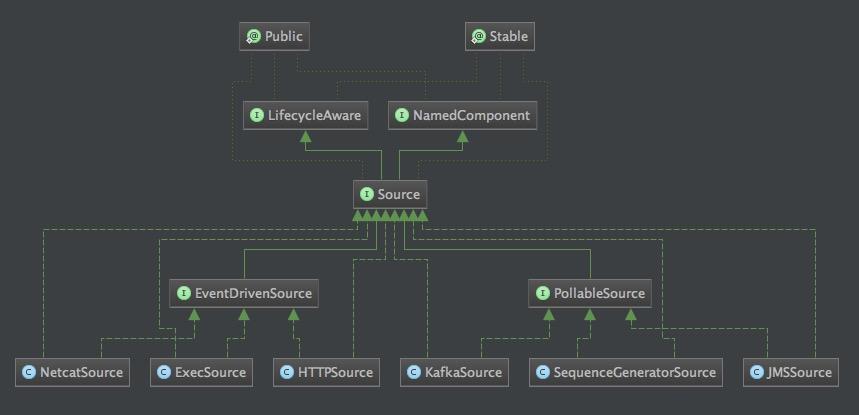
上图展示的Source继承关系类图。
通过类图我们可以看到NetcatSource,ExecSource和HttpSource属于事件驱动模型。KafkaSource,SequenceGeneratorSource和JmsSource属于轮询拉取模型。
Source接口继承了LifecycleAware接口,它的的所有逻辑的实现在接口的start和stop方法中进行。
下图是类关系方法图:
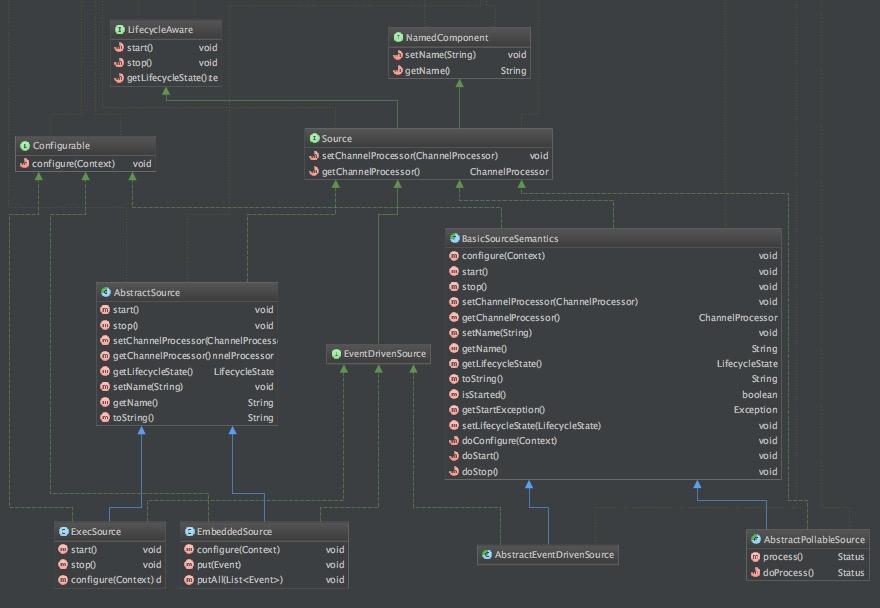
Source接口定义的是最终的实现过程,比如通过日志抓取日志,这个抓取的过程和实际操作就是在对应的Source实现中,比如:ExecSource。那么这些Source实现由谁来驱动的呢?现在我们将介绍SourceRunner类。看一下类继承结构图:
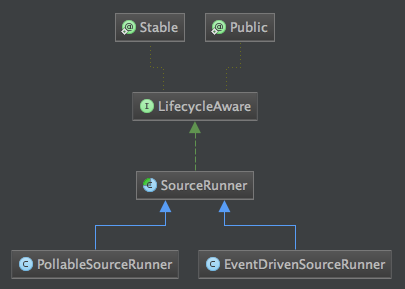
我们看一下PollableSourceRunner和EventDrivenSourceRunner的具体实现:
//PollableSourceRunner:
public void start() { PollableSource source = (PollableSource) getSource(); ChannelProcessor cp = source.getChannelProcessor(); cp.initialize(); source.start(); runner = new PollingRunner(); runner.source = source; //Source实现类就在这里被赋与。 runner.counterGroup = counterGroup; runner.shouldStop = shouldStop; runnerThread = new Thread(runner); runnerThread.setName(getClass().getSimpleName() + "-" + source.getClass().getSimpleName() + "-" + source.getName()); runnerThread.start(); lifecycleState = LifecycleState.START; } //EventDrivenSourceRunner: @Override public void start() { Source source = getSource(); ChannelProcessor cp = source.getChannelProcessor(); cp.initialize(); source.start(); lifecycleState = LifecycleState.START; } 注:其实所有的Source实现类内部都维护着线程,执行source.start()其实就是启动了相应的线程。
刚才我们看代码,代码中一直都在展示channelProcessor这个类,同时最上面架构设计图里面也提到了这个类,那它到底是干什么呢,下面我们就对其分解。
2、Channel组件
Channel用于连接Source和Sink,Source将日志信息发送到Channel,Sink从Channel消费日志信息;Channel是中转日志信息的一个临时存储,保存有Source组件传递过来的日志信息。
先看代码如下:
ChannelSelectorConfiguration selectorConfig = config.getSelectorConfiguration(); ChannelSelector selector = ChannelSelectorFactory.create(sourceChannels, selectorConfig); ChannelProcessor channelProcessor = new ChannelProcessor(selector); Configurables.configure(channelProcessor, config); source.setChannelProcessor(channelProcessor); ChannelSelectorFactory.create方法实现如下:
public static ChannelSelector create(List<Channel> channels, ChannelSelectorConfiguration conf) { String type = ChannelSelectorType.REPLICATING.toString(); if (conf != null){ type = conf.getType(); } ChannelSelector selector = getSelectorForType(type); selector.setChannels(channels); Configurables.configure(selector, conf); return selector; } 其中我们看一下ChannelSelectorType这个枚举类,包括了几种类型:
public enum ChannelSelectorType {/** * Place holder for custom channel selectors not part of this enumeration. */ OTHER(null), /** * 复用通道选择器 */ REPLICATING("org.apache.flume.channel.ReplicatingChannelSelector"), /** * 多路通道选择器 */ MULTIPLEXING("org.apache.flume.channel.MultiplexingChannelSelector"); } ChannelSelector的类结构图如下所示:
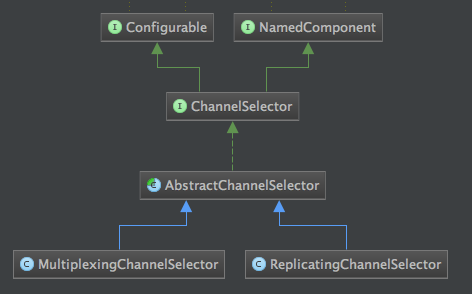
注:RelicatingChannelSelector和MultiplexingChannelSelector是二个通道选择器,第一个是复用型通道选择器,也就是的默认的方式,会把接收到的消息发送给其他每个channel。第二个是多路通道选择器,这个会根据消息header中的参数进行通道选择。
说完通道选择器,正式来解释Channel是什么,先看一个接口类:
public interface Channel extends LifecycleAware, NamedComponent { public void put(Event event) throws ChannelException; public Event take() throws ChannelException; public Transaction getTransaction(); } 注:put方法是用来发送消息,take方法是获取消息,transaction是用于事务操作。
类结构图如下:

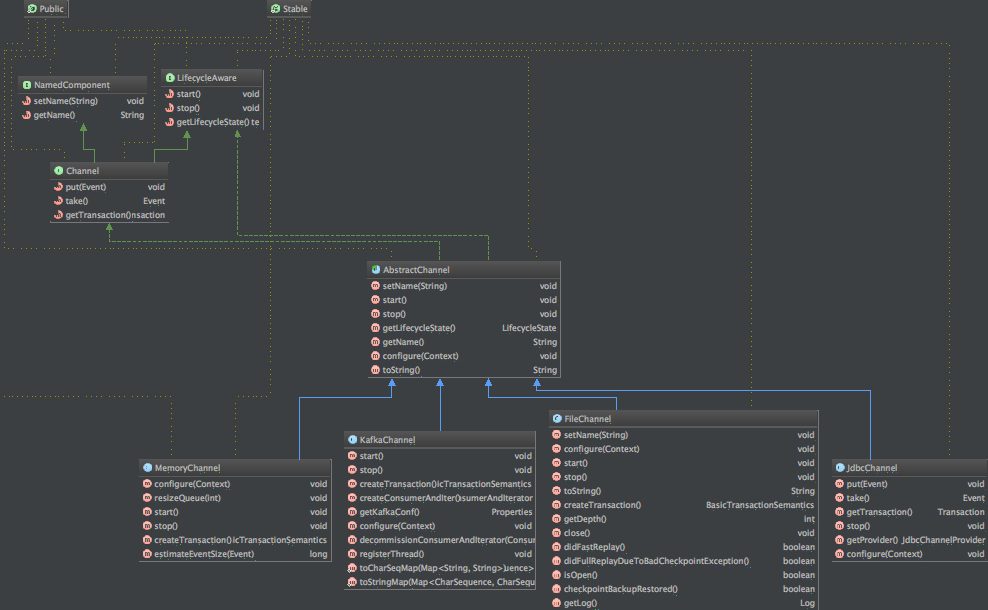
3、Sink组件
Sink负责取出Channel中的消息数据,进行相应的存储文件系统,数据库,或者提交到远程服务器。
Sink在设置存储数据时,可以向文件系统中,数据库中,hadoop中储数据,在日志数据较少时,可以将数据存储在文件系中,并且设定一定的时间间隔保存数据。在日志数据较多时,可以将相应的日志数据存储到Hadoop中,便于日后进行相应的数据分析。
Sink接口类内容如下:
public interface Sink extends LifecycleAware, NamedComponent { public void setChannel(Channel channel); public Channel getChannel(); public Status process() throws EventDeliveryException; public static enum Status { READY, BACKOFF } } Sink是通过如下代码进行的创建:
Sink sink = sinkFactory.create(comp.getComponentName(), comp.getType()); DefaultSinkFactory.create方法如下:
public Sink create(String name, String type) throws FlumeException { Preconditions.checkNotNull(name, "name"); Preconditions.checkNotNull(type, "type"); logger.info("Creating instance of sink: {}, type: {}", name, type); Class<? extends Sink> sinkClass = getClass(type); try { Sink sink = sinkClass.newInstance(); sink.setName(name); return sink; } catch (Exception ex) { System.out.println(ex); throw new FlumeException("Unable to create sink: " + name + ", type: " + type + ", class: " + sinkClass.getName(), ex); } } 注:Sink是通过SinkFactory工厂来创建,提供了DefaultSinkFactory默认工厂,程序会查找org.apache.flume.conf.sink.SinkType这个枚举类找到相应的Sink处理类,比如:org.apache.flume.sink.LoggerSink,如果没找到对应的处理类,直接通过Class.forName(className)进行直接查找实例化实现类。
Sink的类结构图如下:

与ChannelProcessor处理类对应的是SinkProcessor,由SinkProcessorFactory工厂类负责创建,SinkProcessor的类型由一个枚举类提供,看下面代码:
public enum SinkProcessorType {/** * Place holder for custom sinks not part of this enumeration. */ OTHER(null), /** * 故障转移 processor * * @see org.apache.flume.sink.FailoverSinkProcessor */ FAILOVER("org.apache.flume.sink.FailoverSinkProcessor"), /** * 默认processor * * @see org.apache.flume.sink.DefaultSinkProcessor */ DEFAULT("org.apache.flume.sink.DefaultSinkProcessor"), /** * 负载processor * * @see org.apache.flume.sink.LoadBalancingSinkProcessor */ LOAD_BALANCE("org.apache.flume.sink.LoadBalancingSinkProcessor"); private final String processorClassName; private SinkProcessorType(String processorClassName) { this.processorClassName = processorClassName; } public String getSinkProcessorClassName() { return processorClassName; } } SinkProcessor的类结构图如下:
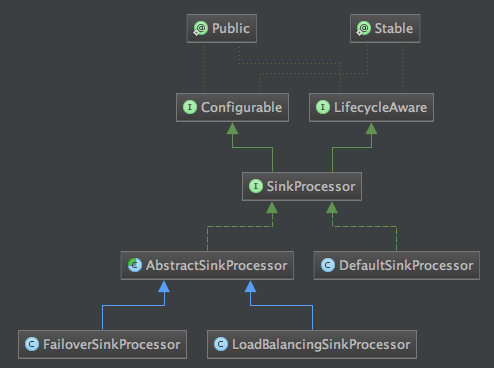
说明:
1、FailoverSinkProcessor是故障转移处理器,当sink从通道拿数据信息时出错进行的相关处理,代码如下:
public Status process() throws EventDeliveryException { // 经过了冷却时间,再次发起重试 Long now = System.currentTimeMillis(); while(!failedSinks.isEmpty() && failedSinks.peek().getRefresh() < now) { //从失败队列中获取sink节点 FailedSink cur = failedSinks.poll(); Status s; try { //调用相应sink进行处理,比如将channel的数据读取存放到文件中, //这个存放文件的动作就在process中进行。 s = cur.getSink().process(); if (s == Status.READY) { //如果处理成功,则放到存活队列中 liveSinks.put(cur.getPriority(), cur.getSink()); activeSink = liveSinks.get(liveSinks.lastKey()); logger.debug("Sink {} was recovered from the fail list", cur.getSink().getName()); } else { // if it's a backoff it needn't be penalized. //如果处理失败,则继续放到失败队列中 failedSinks.add(cur); } return s; } catch (Exception e) { cur.incFails(); failedSinks.add(cur); } } Status ret = null; while(activeSink != null) { try { ret = activeSink.process(); return ret; } catch (Exception e) { logger.warn("Sink {} failed and has been sent to failover list", activeSink.getName(), e); activeSink = moveActiveToDeadAndGetNext(); } } 2、LoadBalancingSinkProcessor是负载Sink处理器
首先我们和ChannelProcessor一样,我们也要重点说明一下SinkSelector这个选择器。
先看一下SinkSelector.configure方法的部分代码:
if (selectorTypeName.equalsIgnoreCase(SELECTOR_NAME_ROUND_ROBIN)) { selector = new RoundRobinSinkSelector(shouldBackOff); } else if (selectorTypeName.equalsIgnoreCase(SELECTOR_NAME_RANDOM)) { selector = new RandomOrderSinkSelector(shouldBackOff); } else { try { @SuppressWarnings("unchecked") Class<? extends SinkSelector> klass = (Class<? extends SinkSelector>) Class.forName(selectorTypeName); selector = klass.newInstance(); } catch (Exception ex) { throw new FlumeException("Unable to instantiate sink selector: " + selectorTypeName, ex); } } 结合上面的代码,再看类结构图如下:
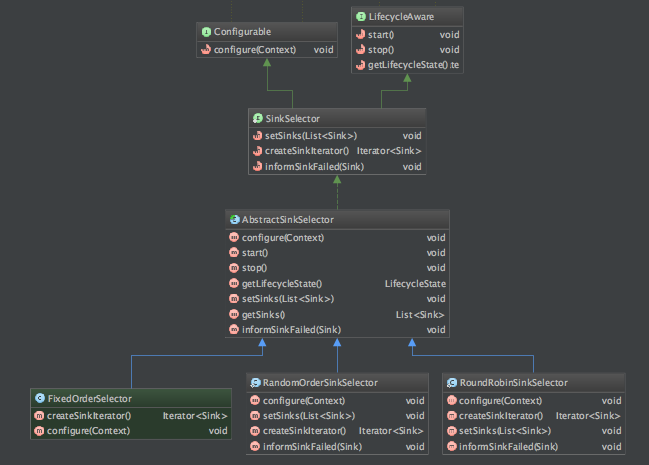
注:RoundRobinSinkSelector是轮询选择器,RandomOrderSinkSelector是随机分配选择器。
最后我们以KafkaSink为例看一下Sink里面的具体实现:
public Status process() throws EventDeliveryException { Status result = Status.READY; Channel channel = getChannel(); Transaction transaction = null; Event event = null; String eventTopic = null; String eventKey = null; try { long processedEvents = 0; transaction = channel.getTransaction(); transaction.begin(); messageList.clear(); for (; processedEvents < batchSize; processedEvents += 1) { event = channel.take(); if (event == null) { // no events available in channel break; } byte[] eventBody = event.getBody(); Map<String, String> headers = event.getHeaders(); if ((eventTopic = headers.get(TOPIC_HDR)) == null) { eventTopic = topic; } eventKey = headers.get(KEY_HDR); if (logger.isDebugEnabled()) { logger.debug("{Event} " + eventTopic + " : " + eventKey + " : " + new String(eventBody, "UTF-8")); logger.debug("event #{}", processedEvents); } // create a message and add to buffer KeyedMessage<String, byte[]> data = new KeyedMessage<String, byte[]> (eventTopic, eventKey, eventBody); messageList.add(data); } // publish batch and commit. if (processedEvents > 0) { long startTime = System.nanoTime(); producer.send(messageList); long endTime = System.nanoTime(); counter.addToKafkaEventSendTimer((endTime-startTime)/(1000*1000)); counter转载于:https://www.cnblogs.com/hd-zg/p/5975399.html
Flume之核心架构深入解析相关推荐
- Tomcat 架构原理解析到架构设计借鉴
点击上方"方志朋",选择"设为星标" 回复"666"获取新整理的面试文章 Tomcat 架构原理解析到架构设计借鉴 Tomcat 发展这 ...
- Hadoop核心架构HDFS+MapReduce+Hbase+Hive内部机理详解
编者按:HDFS和MapReduce是Hadoop的两大核心,除此之外Hbase.Hive这两个核心工具也随着Hadoop发展变得越来越重要.本文作者张震的博文<Thinking in BigD ...
- Java中高级核心知识全面解析——什么是Spring Cloud、需要掌握哪些知识点?(下)
目录 一.必不可少的 Hystrix 1.什么是 Hystrix之熔断和降级 2.什么是Hystrix之其他 二.微服务网关--Zuul 1.Zuul 的路由功能 1)简单配置 2)统一前缀 3)路由 ...
- Java程序员晋升之路:“Java高级核心知识全面解析
前言: 总结这份资料的目的是想记录一下自己这么多年来使用java的一些心得体会,希望可以给大家一些经验,能让大家更好学习和使用Java. 第一部分 扎实的Java基础 (Java基础+容器+并发+JV ...
- Java中高级核心知识全面解析——常用框架(SpringMVC-工作原理详解)
一.先来看一下什么是 MVC 模式 MVC 是一种设计模式. MVC 的原理图如下: 二.SpringMVC 简单介绍 SpringMVC 框架是以请求为驱动,围绕 Servlet 设计,将请求发给控 ...
- 微服务架构深度解析与最佳实践
微服务架构深度解析与最佳实践 微服务架构的概念,现在对于大家应该都不陌生,无论使用 Apache Dubbo.还是 Spring Cloud,都可以去尝试微服务,把复杂而庞大的业务系统拆分成一些更小粒 ...
- 007:Scrapy核心架构和高级运用
本篇内容: Scrapy核心架构和其组件的功能 Scrapy的工作流 Scrapy的中文输出储存 介绍CrawSpider 编写了一个爬虫实战来进行我们的mysql数据库操作 Scrapy的核心架构 ...
- SpringMVC的核心架构示意图<搬代码>
MVC设计模式 MVC设计模式的任务是将包含业务数据的模块与显示模块的视图解耦.这是怎样发生的?在模型和视图之间引入重定向层可以解决问题.此重定向层是控制器,控制器将接收请求,执行更新模型的操作,然后 ...
- SpringCloud之Eureka实战和架构设计解析
SpringCloud之Eureka实战和架构设计解析 Netflix Eureka(后文简称Eureka)是由Netflix开源的一款基于REST的服务发现组件,包括Eureka Server及Eu ...
最新文章
- python第三方库排行-Python模块汇总(常用第三方库)
- c语言编程 新浪博客,[c语言编程]经典编程
- 洛谷 CF1043F Make It One 解题报告
- Hybris Commerce Cloud backoffice的一些使用截图 - OAuth工作中心
- 论文浅尝 - AAAI2020 | 迈向建立多语言义元知识库:用于 BabelNet Synsets 义元预测...
- python字符串常量有什么区别_Python经典面试题:is与==的区别
- NBear简介与使用图解
- jQuery获取div的背景颜色 How to get background color of div?
- 在XP中轻松获取未使用的局域网IP地址
- 手机尺寸相关的概念 +尺寸单位+关于颜色
- python股票交易微信提醒_python实现秒杀商品的微信自动提醒功能(代码详解)
- 6.旋转数组的最小数字
- AI前言技术,一文带你深入了解语音识别的前世今生
- synchronized解析
- PCB板设计后期处理流程及工作步骤有哪些?2021-07-29
- python关系图谱_利用Python+Gephi构建LOL全英雄间的关联图谱
- 【12】Kotlin函数泛型协程
- 关于bootstrapValidator 表单校验remote出现两次重复提交才能验证通过问题处理
- 嵌入式linux启动时间优化
- TorontoCity:众生观天下
